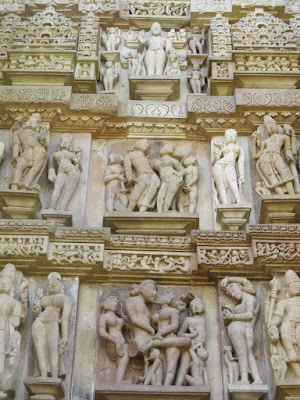
Khajuraho, Khajur-vahika or Khajjurpura, in ancient times, derived its name from the golden date palms ( khajur) which adorned the city gates.
Accounts from a medieval court poet described how, Hemvati, the pretty daughter of a Brahmin priest, one night, had bathed in a lotus-filled pond on a full moon night, that the Moon God was so awe-struck and seduced by her beauty that he descended upon earth in human form and ravished her! The distressed Hemvati threatened to curse the God for ruining her life and reputation and to make amends, the Moon God promised her that she would become the mother of a valiant son who would become a great King who would build a city with numerous temples surrounded by gardens and lakes. The King would also perform 'yagya' (religious ceremonies) through which her sins would be washed away.
Chandravarman, the son that Hemvati gave birth to, became the founder of the Chandela dynasty and built 85 temples at Khajuraho ( of which only about 20 remained today).
followed by the hindu temple dome
on the roof of this temple....
 The Hindu dynasties at Khajuraho were in the 15th century overran by the Moghuls. Some of the temples built here had domes of mosques, Buddhist and Hindu temples side-by-side, in a row, as pictured above, reflecting the peaceful co-existence of peoples of different faiths in this region.
The Hindu dynasties at Khajuraho were in the 15th century overran by the Moghuls. Some of the temples built here had domes of mosques, Buddhist and Hindu temples side-by-side, in a row, as pictured above, reflecting the peaceful co-existence of peoples of different faiths in this region.'ardha mandapa' ( entrance porch)
of the Kandariya Mahadeva Temple...

the Kandariya Mahadeva Temple
the largest temple at the Khajuraho complex
 another view of the Kandariya Mahadeva Temple....
another view of the Kandariya Mahadeva Temple....with sculptures of human beings and animals depicting life of the day,
humans being involved with material and sensual activities...
and at higher levels the walls become devoid of etchings
plain and simple....
reflecting the simplicity of life as one attains
a higher degree of spirituality...

The temples at Khajuraho were built in the 10th century and represented religiosity, patronage, artistic genius and artistic sensibility all at once. It was built during the Chandela Dynasty and belonged to the Shaivism and Vaishnavism sects of Hinduism. The temples have no enclosure walls and were built on a high and solid raised platform. They have elegant proportions and are adorned with sculptures on the exterior and interior walls.
The sculptures included numerous dieties, their attendants, celestial maidens in sensous positions and provocative postures, dancers and musicians and couples in various refinements of courtly love. Some of these famous postures are said to follow the Kama Sutra, the ancient Indian manuals of the art of making love.
If the 'temples' can be said to have a theme, it has to be about "woman". It is a celebration of woman and her myriads of moods and facets - writing letters, applying kohl to the eye and doing facial make-up, dancing etc etc. The philosophy of that time was that the enjoyment of the delights of 'arth' ( material wealth) and 'karma' ( sensual pleasures) go along with performing one's 'dharma' ( duty).

a celebration of 'women'...?








the existence of sexual perversion as in the form of
'bestiality' ( sex with animals) as depicted here...
at the Brahmin priest (bald-headed) who was potrayed here
in sexual intercourse with a court maiden ( extreme right)
while Lord Ganesha ( potrayed here as the elephant)
watched the act with a grin in his eyes.....
(the Brahmin priest was human after all...)







1 comment:
खजुराहो के बारे में बहुत बढ़िया जानकारी दी है आपने
Post a Comment